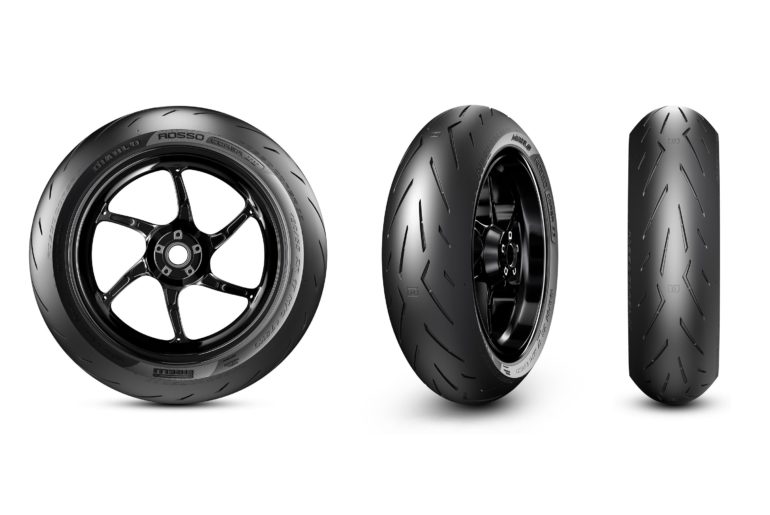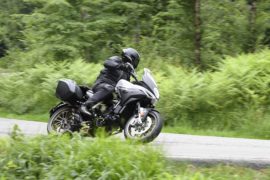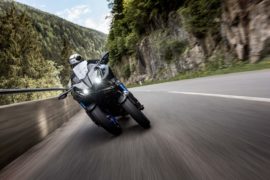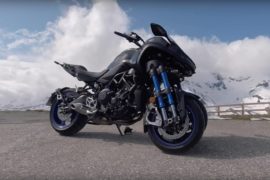When I was a new rider, I cut my teeth on Pirelli Corsa tires (and later on the Pirelli Corsa III), and as I got into doing track days, the Pirelli Diablo Rosso Corsa became my tire of choice, both as a track tire and also as a street tire.
Almost as grippy as “the good stuff” and considerably cheaper than track-focused tires of the time, the Diablo Rosso Corsa hit that sweet spot of performance and price that my relatively unexperienced two-wheeled-self required.
Best of all, after a few track days, I could swap-out the rubber on my track bike for road duty, and thus had a nice supply of new rubber for my street biking needs.
As Asphalt & Rubber became a larger part of my life, this tire strategy had to give way to trying other brands and other tires, but I was recently intrigued when Pirelli told me that they were updating this stalwart in their sport bike tire lineup, as there isn’t a lineage of tire that I am more familiar with on the market.
Creating the Pirelli Diablo Rosso Corse II tire for the 2018 model year, the Italian brand first invited A&R out to South Africa to see if this new incarnation of the Corsa lived up to the high-water mark its predecessor left behind. In short, it did.
But, only a couple days with a new tire can be tough to use to form an opinion. Not content to be so easily swayed, I have since spent a considerable amount of time on this new Pirelli.
Riding three more trackdays (on three different tracks), trying six bikes in total, and plowing down a thousand street miles later, I can honestly say that the Pirelli Pirelli Diablo Rosso Corse II might be the best sport bike tire on the market. Let me explain.
First, A History Lesson
Pirelli has flooded the sport bike tire segment with five different offerings, all of which have confusingly similar names, and offer different levels of performance.
It should be noted that no other brand has this many tire offerings for sport bikes, a nod to Pirelli’s commitment to this segment.
The street-focused Diablo Rosso III starts the range and is a true street bike tire. Next up is the new Diablo Rossi Corsa II, which is still sold as street-focused tire, but it also starts the list of Pirelli tires that have been designed for use on a race track.
More aggressive on the list is the Diablo Supercorsa SP, which is still a high-performance street tire, though it has leanings towards track riding, and is the most common OEM fitment for America-bound superbikes.
Building from there is the similar-looking Diablo Supercorsa SC, which starts Pirelli’s race tire lineup. Though visually similar to the SP, the SC has a different compound and structure, and its is essentially a race slick with enough siping to be DOT legal.
Finishing up the lineup is the Diablo Superbike tire family, which is a full-fledged racing tire, and it comes in several compound choices.
If this all sounds confusing, well…it is. The key thing to remember is that with any sport bike tire family, there is a balance of street vs. track performance that is made as you move up the the lineup.
While there are some inherent similarities between the tires, what makes the Supercosa SC a great track day or race tire also makes it a poor choice for the street, and the inverse can be said of the Diablo Rosso III.
What the Pirelli Diablo Rosso Corsa II aims to do, however, is to strike a balance between these pursuits, and be the tire that is the best of both worlds for street and track use.
A fine line to walk, Pirelli has done a remarkable job of making a well-behaved and versatile street tire that is more than capable of providing the grip needed for knee-dragging fun on the track.
Getting Technical
To do achieve this, the Italian brand has relied on a several key technologies for the Diablo Rosso Corsa II. The most important of which is a multi-compound tire design.
Two tire compounds are used on the DRC2 front, and three tire compounds are used on the DRC2 rear, and each of them has a specific purpose.
On the edge of the tire is a compound that is 100% carbon black, the good sticky stuff that racing slicks are made of.
Also note that Pirelli has removed siping from the last inch or so on the edge of the tire. This means that when you are at maximum lean, the tire’s contact patch looks more like a slick’s, which adds to the cornering grip.
Moving to the shoulder on the rear tire (and the center of the front tire), the Pirelli Diablo Rosso Corsa II uses a 100% silica compound. This not only increases the tire life on this part of the tire, it also provides exceptional grip in the wet and the cold.
This achieves two goals for Pirelli: 1) its makes the DRC2 have better tire life, especially where the tire is most likely to get chewed up by high-horsepower motorcycles, and 2) it provides this street tire with the tools it needs to react to the harsh conditions street riders face.
The last compound is only on the rear tire, and it is a 70% silica compound, offering a mix of longevity and grip to the rear tire, ideal for high-mileage duty.
The compounds used on the Pirelli Diablo Rosso Corsa II are not the only thing that has changed, as the profile of the DRC2 also differs from its predecessor.
To increase grip when the bike is leaned over, Pirelli has created a dual-radius tire shape. This basically means that the profile of the tire transitions near the shoulder, with a wider radius shape, so the tire has more contact with the asphalt, and thus has more grip.
This creates more feel when the Diablo Rosso Corsa II is transitioning into a lean, and more stability once the bike achieves a lean of 35° or more.
According to Pirelli, this means that the Diablo Rosso Corsa II can lean 4° more than its predecessor, and also carry more speed at that lean.
In fact, comparing the Pirelli Diablo Rosso Corsa II to the previous generation, the Italians say they have improved this tire in a multitude of ways.
Benchmarking the Diablo Rosso Corsa II against the Diablo Rosso Corsa, Pirelli’s claims are pretty strong. Looking at the graphic above, we can see where the use of the multi-compound rubber, especially with the added silica, makes improvements on handling and longevity.
Normally these aspects are mutually exclusive to each other, but advances in the use of silica has really changed the game in this regard. Most race tires designed for use in the rain are 100% throughout the entire tire, for example.
According to Pirelli, in only two aspects does the DRC2 not exceed the DRC1: high-speed stability and race-track wear. This is likely because carbon black is still used for the last edge of the tire, and the soft carcass design philosophy that Pirelli uses has remained in place for the Diablo Rosso Corsa II.
Of course, we would be remiss if we just took Pirelli’s word for all this, which is why we spent so much time putting these tires through their paces. So, let’s get to the part where I tell you how they stack up, in the real world.
Wet, Dry, Track, & Street – How It Rides
Even before spinning a lap, or traversing a mile on the Diablo Rosso Corsa II tires, I was able to solicit some slightly unbiased opinions from a couple manufacturers that were planning to use the new Pirellis as OEM equipment.
I wanted to know the answer to a simple question: why did they pick the DRC2 for their sport bike rubber over the other available brands?
The answer I heard over and over was wet grip. “The Pirelli Diablo Rosso Corsa II has phenomenal grip in the wet” one R&D agent told me. I would get to test that statement first thing, upon my landing in South Africa.
Getting a deluge of rain on our street ride, it was a baptism by water…which I guess is really just a normal baptism, except maybe a bit colder. The Pirelli Diablo Rosso Corsa II lived up to the hype though. The wet grip was indeed superb.
Riding the famous Highway 22 near Kruger National Park, the BMW S1000R I was provided gave me no troubles, even when getting on the gas and brakes. In fact, it was hard to coax the Pirelli tires out of form on the African roads.
That is of course at a standard moto-journalist street pace, which while probably outside the envelope of what is considered “prudent” in fair society, it is still not full gas.
To test this wet grip theory further, I later took the Pirelli Diablo Rosso Corsa II tires to somewhere that we could really get on the gas, which was one of Washington’s finest race courses, The Ridge Motorsports Park.
An undulating track with a diversity of turns, a track day in Washington wouldn’t quite be complete without some rain, wind, and combination of the two.
Late in the day, I would get my wish, and the rain came. “Heads up, there’s rain on the track now” the flagman would tell me, as I lined up to get out on the track – as if the drops on my visor weren’t enough of a giveaway.
A few bikes joined me on the grid, but after a few laps, myself and my Ducati Streetfighter 1098 were the only things I could see circulating at The Ridge.
This is where having a street tire on a race track is actually a benefit. Silica-enfused compounds, a street-bike structure, and ample siping meant that the Diablo Rosso Corsa II was a better choice for the conditions than the race slicks that most of the advanced riders were using.
Able to grip wet asphalt, and more importantly, able to handle the cooling temperatures, I had traction wear others didn’t.
On a track bike, you might swap in a set of rain tires for these conditions (or just not go out, as the case was for many), but you can’t do that when you are riding on the street, which is why having a tire that is capable of operating in a variety of adverse conditions is a must.
It’s also a must when you’re doing a track day in the rain, on a 150hp motorcycle that has no traction control or ABS brakes…but, I digress.
Firmly planted, the Pirelli Diablo Rosso Corsa II tires gave me no troubles at The Ridge, and they provided enough feedback to show where the traction limit was on the track.
The Pirelli Diablo Rosso Corsa II tires are not rain tires, but for a street rider, the Pirelli DRC2 tires provide a deep level of performance, especially on the shoulder of the tire.
Under less adverse conditions, the Diablo Rosso Corsa II shines as well (pun moderately intended, mostly for our podcast listeners).
Back to our time in South Africa, our press launch took us from the rain in Kruger (stop singing Toto), to the drier weather at the Kyalami Grand Prix Circuit outside of Johannesburg.
Easily one of the best tracks I have ever ridden, Kyalami offers a little bit of everything in terms of track conditions, with a fun and flowing track layout. Seriously, this African gem is a strong candidate for topping Phillip Island as my favorite circuit to ride.
Fresh from the Ducati Panigale V4 S launch in Valencia, my first stint at Kyalami was onboard Ducati’s newest superbike – a machine that I have ridden with both the Supercosa SP street/track tires as well as the Diablo Superbike race slicks.
This made the 1,103cc superbike a strong benchmark to use for a first impression of the Pirelli Diablo Rosso Corsa II as a track tire.
I was expecting the 214hp V4 engine to spin up these measly street tires no problem, but instead I was impressed by how much they stuck to the asphalt. In fact, the DRC2 stuck really well.
Dragging knees at will, the Panigale V4 gave me no trouble as I gave more gas. The feeling from the Diablo Rosso Corsa II isn’t the same as the more track-focused Supercorsa SP tires, and the grip certainly isn’t the same as the Diablo Superbike slicks, but that’s like saying water is wet.
On the edge of the tire, the grip with the Diablo Rosso Corsa II was very similar, maybe just a step below, to the Supercorsa SP.
It is when you are hard on the brakes where you see the most difference between the two tires, as you lose some feeling from the DRC2 front tire, and with the rear tire considerably easier to lock-up, when compared to the SP.
Still, the impression was strong with the Pirelli Diablo Rosso Corsa 2. Hitting the fast sweepers that are Turn 4 and Turn 10 (the later having a sizable drop in elevation as well), the rear tire stayed firmly planted, despite asking for a lot with the throttle hand.
Taking later stints on a KTM 1290 Super Duke R, MV Agusta F3 800 RC, and Yamaha YZF-R1, the feeling was the same, despite the range of engines, tire sizes, and riding positions.
This is a point worth adding more to, as sometimes tires differ in their performance with different sizes and different bikes. Finding consistency in a tire across a multitude of machines is a strong indicator of the level of R&D that went into the tire.
It used to be that the Diablo Rosso Corsa was an easily noticeable step down on the track from the Supercorsa SP, as I have had a couple chances to try the two tires back-to-back on the same superbike, but Pirelli has made the Diablo Rosso Corsa II much closer in track performance to Supercorsa SP.
The slick tire edge certainly helps with track grip, but the compound and construction choice have also helped close the gap. Of course, the worry is then how this affects road use.
With nearly 1,000 miles of road riding thus far, both on Pirelli’s bikes and on my own, so far the trade off seems not to be an issue. Pirelli quotes about 5,500 miles of rear tire life on the Diablo Rosso Corsa II, which is more than ample.
The previous generation tire lasted closer to 3,000 miles (after two or three track days), so I will be curious to see if the DRC2 surpasses that mark, and if so, by how much.
So far, the Pirellli Diablo Rosso Corsa II has impressed me with its quick warm-up (a necessity in the shifty weather that Oregon has, even in the summer time), its track grip, and its overall feel.
Conclusions and Caveats
In case you haven’t noticed, I am pretty amped on the Pirelli Diablo Rosso Corsa II – I think the Italians hit things out of the park with this one, and improved on a tire that was already at the top of the heap.
I am not one that uses superlatives easily, and I won’t deviate from that standard here. The OCD-scientist in me needs to reserve a “best in class” distinction for a time when more back-to-back analysis can be made with a group of competitor tires.
Until then, I will say simply this: I am impressed with the Pirelli Diablo Rosso Corsa II. If I was spending my hard-earned blogging dollars on a set of tires for the street bike in my garage, so far, these would be it.
I am curious to see how many miles I can coax out of the Diablo Rosso Corsa II, and more importantly, I am curious to see how they perform when thousands of miles and dozens of heat cycles have been put through them.
It is one thing to make a tire that performs when it is still fresh from the factory, but it is an entirely different animal to keep that level of performance over the life of the tire. As such, we will revisit this conversation in a couple months’ time.
In the meantime, for Pirelli Diablo Rosso Corsa II tire pressures on the track (with a high-performance sport bike), we would recommend “hot” pressures of 32 psi (front) / 28 psi (rear), and adjust from there for wear and grip.
If you are going out on the track with a “cold” Diablo Rosso Corsa II tire, we recommend starting with pressures of 29 psi (front) / 25 psi (rear), and then checking the “hot” pressures after each session.
For tire pressures on the street, you should always follow the OEM-recommended tire specifications for your specific motorcycle model – but you already knew that.
Photos from the Kyalami Grand Prix Circuit:
Photos from Highway 22 – Kruger, South Africa:
Photos from The Ridge Motorsports Park:
Photos from Portland International Raceway:
South Africa Photos: Milagro; Portland Photos: 360 Photography
Helmet: Bell Pro Star Flex & AGV Pista GP R; Jacket: Dainese D-Air Misano; Pants: Dainese Misano; Boots: Dainese Axial Pro In; Gloves: Racer Glove High Speed






























